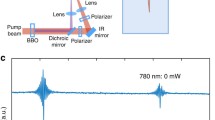Abstract
The temperature dependence of the photoluminescence (PL) spectrum of silicon quantum dots (QDs) is studied both theoretically and experimentally, and the time of the corresponding electron-hole radiative recombination is calculated. The dependence of the recombination time on the QD size is discussed. The experiment shows that the PL intensity decreases by approximately 60% as the temperature increases from 77 to 293 K. The calculated characteristic recombination time has only a weak temperature dependence; therefore, the decrease in the PL intensity is associated primarily with nonradiative transitions. It is also shown that the phonon-assisted radiation is much more efficient than the zero-phonon emission. Moreover, the zero-phonon recombination time depends on the QD radius R as R 8, whereas the phonon-assisted recombination time depends on this radius as R 3.
Similar content being viewed by others
References
S. Takeoka, M. Fujii, and S. Hayashi, Phys. Rev. B 62(24), 16820 (2000).
Y. Kanemitsu and S. Okamoto, Phys. Rev. B 56(24), 15561 (1997).
Y. Kanemitsu, Phys. Rev. B 53(20), 13515 (1996).
Y. Kanemitsu, N. Shimizu, T. Komoda, et al., Phys. Rev. B 54(20), 14329 (1996).
T. Shimizu-Iwayama, S. Nakao, and K. Saitoh, Appl. Phys. Lett. 65(14), 1814 (1994).
G. A. Kachurin, I. E. Tischenko, K. S. Zhuravlev, et al., Nucl. Instrum. Methods Phys. Res. B 122, 571 (1997).
D. I. Tetelbaum, S. A. Trushin, V. A. Burdov, et al., Nucl. Instrum. Methods Phys. Res. B 174, 123 (2001).
T. Takagahara and K. Takeda, Phys. Rev. B 46(23), 15578 (1992).
D. I. Tetelbaum, V. A. Burdov, S. A. Trushin, and A. N. Mikhaylov, in Proceedings of 10th International Symposium on Nanostructures: Physics and Technology (St. Petersburg, 2002), p. 206.
A. I. Ansel’m, Introduction to the Theory of Semiconductors (Nauka, Moscow, 1978).
M. Voos, Ph. Uzan, C. Delalande, et al., Appl. Phys. Lett. 61(10), 1213 (1992).
A. A. Kopylov, Fiz. Tekh. Poluprovodn. (Leningrad) 16(12), 2141 (1982) [Sov. Phys. Semicond. 16, 1380 (1982)].
V. A. Burdov, Zh. Éksp. Teor. Fiz. 121(2), 480 (2002) [JETP 94, 411 (2002)].
M. S. Hybertsen, Phys. Rev. Lett. 72(10), 1514 (1994).
O. J. Glembocki and F. H. Pollak, Phys. Rev. B 25(2), 1193 (1982).
Author information
Authors and Affiliations
Additional information
__________
Translated from Fizika Tverdogo Tela, Vol. 46, No. 1, 2004, pp. 31–34.
Original Russian Text Copyright © 2004 by Belyakov, Burdov, Gaponova, Mikhaylov, Tetelbaum, Trushin.
Rights and permissions
About this article
Cite this article
Belyakov, V.A., Burdov, V.A., Gaponova, D.M. et al. Phonon-assisted radiative electron-hole recombination in silicon quantum dots. Phys. Solid State 46, 27–31 (2004). https://doi.org/10.1134/1.1641914
Issue Date:
DOI: https://doi.org/10.1134/1.1641914




